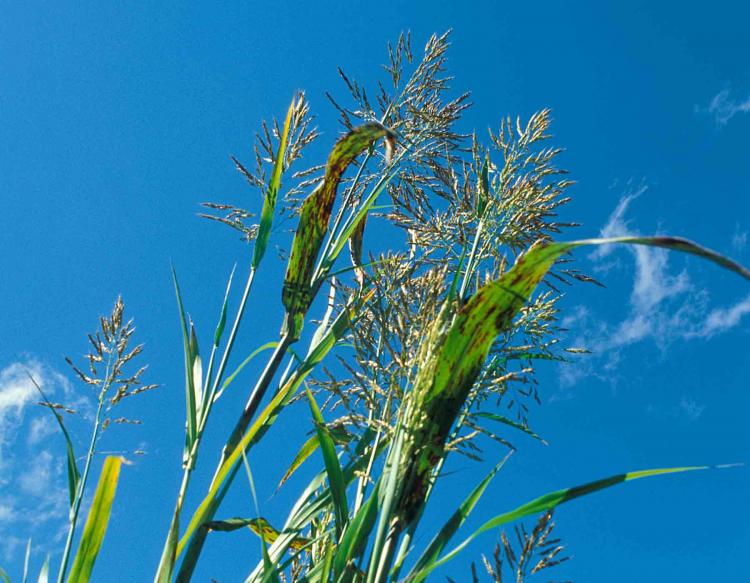Johnson grass (Sorghum halepense) is a tall, coarse, perennial grass with stout rhizomes. It grows in dense clumps or nearly solid stands. It was introduced into the United States as a forage crop but became problematic not only to natural communities but to agriculture as well.
Effects on Natural Communities
Johnson grass invades riverbank communities and disturbed sites, particularly fallow fields and forest edges, where it crowds out native species and slows succession. It quickly dominates the herbaceous flora, reduces plant diversity, and is unsightly to observers. This grass is a serious threat in many old fields where succession to forest communities is desired.

Title
General Control Practices
To eradicate Johnson grass, control measures must be thorough. Various cultural practices and chemical herbicides will effectively control germinating seed, seedlings, and established plants. Objectives of a good control program include:
- Prevent production and spread of seed
- Destroy seedlings before rhizomes are formed
- Weaken and kill existing rhizomes
- Control new infestations as they appear
Title
Recommended Practices in Natural Communities of High Quality
Initial effort in areas of heavy infestation
Johnson grass does not infest areas of high natural quality heavily except for the naturally disturbed environment such as along river banks where it is difficult to control selectively. Seed panicles should be cut and removed from the area where practical. Dense patches can be controlled by spraying the foliage with 2 percent Roundup (a formulation of glyphosate). Best results are obtained when glyphosate is applied to plants that are 18 inches tall to early flowering stage.
During this period the herbicide will be most effectively translocated to the roots and rhizomes. Care should be taken to avoid contacting non-target plants, since Roundup is a nonselective herbicide. Do not spray so heavily that herbicide drips off the target species. The herbicide should be applied while backing away from the area to avoid walking through wet herbicide. By law, herbicides may only be applied as per label instructions.
Effort in areas of light infestation
Clumps and individual plants may be hand pulled during June, just after a rain when the ground is soft. All plant parts should be removed from the area. Broken stems and roots left in the ground should be dug up if only a small area is involved. It is more effective to spot-treat the individual plants with herbicide than to pull them, and large clumps can be sprayed with 2 percent Roundup using a hand sprayer or backpack sprayer. Herbicide treatment may need to be repeated for several years to ensure good control.
Maintenance control
Preferred treatment is hand pulling of individual plants immediately upon discovery. All plant parts, including rhizomes, must be removed. It may be necessary to hand pull a population several times to obtain control. Surrounding seed sources should be eliminated where possible to prevent continual re-invasion.
Title
Recommended Practices on Lands Other Than High-Quality Natural Areas
Initial effort in areas of heavy infestation
Repeated and close mowing kills Johnson grass seedlings, prevents seed production, and reduces rhizome growth and regrowth of shoots. Sites may be tilled where it is practical (e.g. abandoned cropland) and the exposed roots left to winter kill. Repeated tillage (e.g. six times at two-week intervals during the growing season) prevents rhizome development and reduces Johnson grass populations. Limited early season tillage, however, encourages rhizome growth by spreading pieces of the rhizomes. In a monoculture, livestock may be used to eliminate the Johnson grass by grazing. Spraying 2-percent Roundup on foliage using a tractor and power sprayer provides effective control.
Effort in areas of light infestation
Cutting and removal of seed heads during early July and then spot application of 2-percent Roundup to the foliage usually will be effective if continued for three to four years.
Maintenance control
Preferred treatment is the same as given above for high-quality areas. Another treatment is spot application of 2-percent Roundup to eliminate invading individuals the first year and to eliminate all surrounding seed sources.
Title
Failed or Ineffective Practices
The following practices should be avoided:
- Hand control: too slow and not practical in large areas where infestations are heavy. Rhizomes break easily and are often left in the ground. Large mature plants are almost impossible to pull by hand.
- Mowing: usually does not kill or eliminate established plants.
- Fire: more research needed. Spring burns may encourage regrowth.
- Herbicides: single applications seldom eliminate the species from an area.
- Tillage: not practical in many places because of terrain and erosion hazard. It seldom is effective by itself and allows other weedy species to invade. It may also destroy native species present.
- Grazing: Grazing increases the potential for introducing other exotic plants. Livestock trample the soil and damage other species.
- Manipulation of water levels: Johnson grass does not typically occur in areas where water level manipulation is practical.
- Biological controls: livestock grazing may reduce plant vigor, but has negative impacts (e.g., excessive trampling, damage to other species, soil compaction) associated with it. No other biological controls are known that are feasible in natural areas.





















